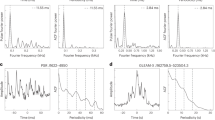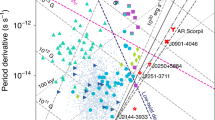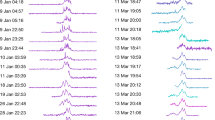Abstract
The constancy of frequency in the recently discovered pulsed radio sources can be accounted for by the rotation of a neutron star. Because of the strong magnetic fields and high rotation speeds, relativistic velocities will be set up in any plasma in the surrounding magnetosphere, leading to radiation in the pattern of a rotating beacon.
This is a preview of subscription content, access via your institution
Access options
Subscribe to this journal
Receive 51 print issues and online access
$199.00 per year
only $3.90 per issue
Buy this article
- Purchase on SpringerLink
- Instant access to full article PDF
Prices may be subject to local taxes which are calculated during checkout
Similar content being viewed by others
References
Hewish, A., Bell, S. J., Pilkington, J. D. H., Scott, P. F., and Collins, R. A., Nature, 217, 709 (1968).
Pilkington, J. D. H., Hewish, A., Bell, S. J., and Cole, T. W., Nature, 218, 126 (1968).
Drake, F. D., Gundermann, E. J., Jauncey, D. L., Comella, J. M., Zeissig, G. A., and Craft, jun., H. D., Science, 160, 503 (1968).
Drake, F. D., Science (in the press).
Drake, F. D., and Craft, jun., H. D., Science, 160, 758 (1968).
Tanenbaum, B. S., Zeissig, G. A., and Drake, F. D., Science (in the press).
Thorne, K. S., and Ipser, J. R., Ap. J. (in the press).
Lyne, A. G., and Smith, F. G., Nature, 218, 124 (1968).
Author information
Authors and Affiliations
Rights and permissions
About this article
Cite this article
GOLD, T. Rotating Neutron Stars as the Origin of the Pulsating Radio Sources. Nature 218, 731–732 (1968). https://doi.org/10.1038/218731a0
Received:
Issue Date:
DOI: https://doi.org/10.1038/218731a0



